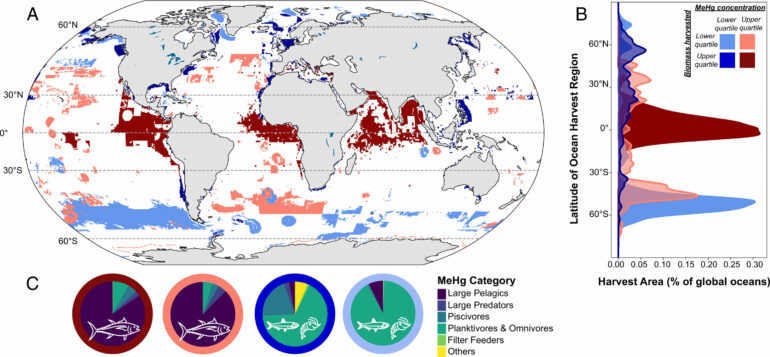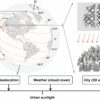Industrial fishing practices are increasing human exposure to methylmercury, a neurotoxicant associated with developmental delays in children and impaired cardiovascular health in adults.
New research from the Harvard John A. Paulson School of Engineering and Applied Sciences (SEAS), in collaboration with the University of Delaware and the University of British Columbia, finds that industrial fisheries that harvest tuna and other large fish in tropical and subtropical waters account for more than 70% of all methylmercury fished from the ocean.
The research, published in the Proceedings of the National Academy of Sciences, explores the complex interplay between biology, chemistry and the global seafood market.
Let’s begin with the market.
The market for so-called large pelagic seafood, which includes tuna, has sharply increased in recent years, thanks in part to advances in industrial fishing such as onboard freezing and fish aggregating technology.
Since the 1980s, these technologies have led to an explosion of tuna fisheries in tropic and subtropic waters, making tuna more available in markets and grocery stores across the globe. As a result, tuna and other large pelagic fish have become an increasingly common part of people’s diets.
The problem is, large pelagic seafood typically has higher levels of methylmercury than other types of fish.
Let’s look at chemistry and biology.
Mercury is emitted into the atmosphere from coal-fired power plants, waste-incineration, industry and mining—as well as from some natural sources such as volcanoes. From the atmosphere, mercury gets deposited on land and into the oceans, where microorganisms in water convert mercury into methylmercury.
These microorganisms generate a lot of methylmercury in warm, tropic and subtropic waters. Methylmercury is the only form of mercury that biomagnifies in food webs, meaning that organisms at the top of the food chain have many times more methylmercury than those at the bottom.
The result is that top marine predators in tropic and subtropic oceans are going to have much higher levels of methylmercury than other types of fish. Those top predators include tuna.
“Large-scale industrial fisheries are fishing top predators in the high methylation zone,” said Mi-Ling Li, an Assistant Professor of Environmental Chemistry and Toxicology at the University of Delaware and first author of the paper.
“Our research finds that the current fishing choices are amplifying human methylmercury exposure. We need to find better options.”
Li began this research as a postdoctoral fellow at SEAS in the lab of Elsie Sunderland, the Fred Kavli Professor of Environmental Chemistry and Professor of Earth and Planetary Sciences.
Sunderland, Li and their collaborators used high resolution catch data from global fisheries to trace the origins and amounts of methylmercury exposure from seafood. The team found that tropical and subtropical fisheries that harvest large pelagic fish such as tuna account for more than 70% of the methylmercury fished from the ocean.
The team also noted that the healthy micronutrients found in fish, such as selenium and omega-3 fatty acids, are lowest in seafood harvested from warm, low latitude regions and may be further reduced by ocean warming.
“Marine seafood is an essential, and often healthy, source of protein and nutrition for billions of people around the globe. Extensive harvests of large pelagic species by industrial fisheries, particularly in the tropics, are creating a demand for the types of seafood that are highest in harmful methylmercury and lowest in healthy nutrients,” said Sunderland, the senior author on the paper.
Small pelagic fish, such as anchovies, sardines, and herring, offer a healthier alternative. They have much lower concentrations of methylmercury and are much higher in omega-3 fatty acids than their larger cousins.
The research team also looked at methylmercury exposure among subsistence fisheries—small scale fishing that feeds families or small communities. The researchers estimated that 84% to 99% of subsistence fisheries globally likely exceed methylmercury exposure thresholds. These communities consume significantly more fish than the general population.
“Subsistence populations are paying the price for pollution they had no role in emitting,” said Sunderland. “Our research highlights the need for both stringent controls on global pollution and better accounting for human nutrition in fishing choices.”
More information:
Mi-Ling Li et al, Global fishing patterns amplify human exposures to methylmercury, Proceedings of the National Academy of Sciences (2024). DOI: 10.1073/pnas.2405898121
Provided by
Harvard John A. Paulson School of Engineering and Applied Sciences
Citation:
Tropical and subtropical industrial fisheries account for about 70% of methylmercury fished from the ocean: Study (2024, September 24)



